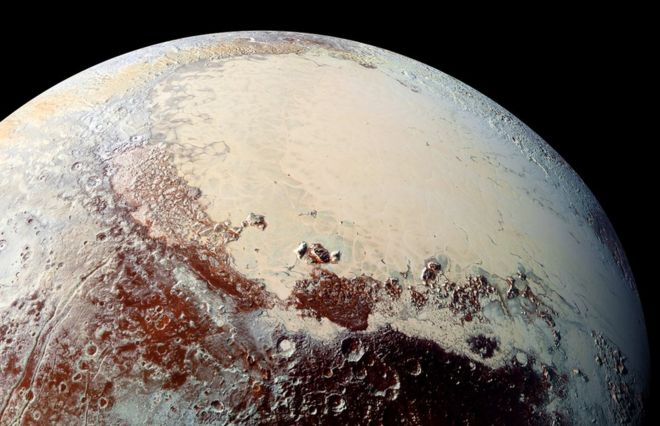
Scientists say they have found evidence of dunes of frozen methane on Pluto.
The research, which is published in the journal Science, suggests that the distant world is more dynamic than previously thought.
Pluto’s atmosphere was believed to be too thin to create the features familiar in deserts on Earth.
The findings come from analysis of the startling images sent back by Nasa’s New Horizons mission, which flew close to Pluto in July 2015.
After an epic trek through the Solar System that took nearly a decade, New Horizons sped by at a speed of 58,536 km/h (36,373 mph), gathering data as it passed.
In their study, the researchers explain how they studied pictures of a plain known as Sputnik Planitia, parts of which are covered with what look like fields of dunes.
They are lying close to a range of mountains of water ice 5km high.
The scientists conclude that the dunes are 0.4-1km apart and that they are made up of particles of methane ice between 200-300 micrometers in diameter – roughly the size of grains of sand.
The paper’s lead author is Dr Matt Telfer, a physical geographer at the University of Plymouth. He told BBC News: “We can’t see individual grains but what we are able to identify dunes, and characterise their basic physical parameters, and the density of the atmosphere that they’ve been formed under.
“And we can measure some basic things like how far apart they are spaced, and have an estimate at least of the wind speeds that are forming them.
“We can feed all that back into a physical model and from that deduce what the size of the grains must be.”
To be able to form, dunes need an atmosphere dense enough to make wind transport possible, a supply of dry particles, and a mechanism that lifts particles off the ground.
At first sight, none of those conditions seem to be met on Pluto.
But Dr Telfer and his colleagues calculate that the dunes may be in one of the windiest areas of the Pluto with wind speeds reaching up to 10m/sec – enough to keep particles moving.
The wind is generated as air flows downhill from the neighbouring mountains and also as frozen material sublimates – or turns directly into gas.
They believe that the dunes are composed of grains of methane, and maybe of nitrogen as well, and that a “reservoir” of methane may exist in the snowpack of the mountains.
As for the process of “lofting” the grains off the ground, the paper suggests that the driver could be a slight warming from the distant Sun, raising the temperature above the frost point of nitrogen: -230C.
With that warming of the ice below the surface, methane crystals should enable nitrogen ice to sublimate – and that would allow the methane crystals to be wafted into the atmosphere.
Dr Telfer says the analysis provides a new insight to Pluto and also changes our view of it.
